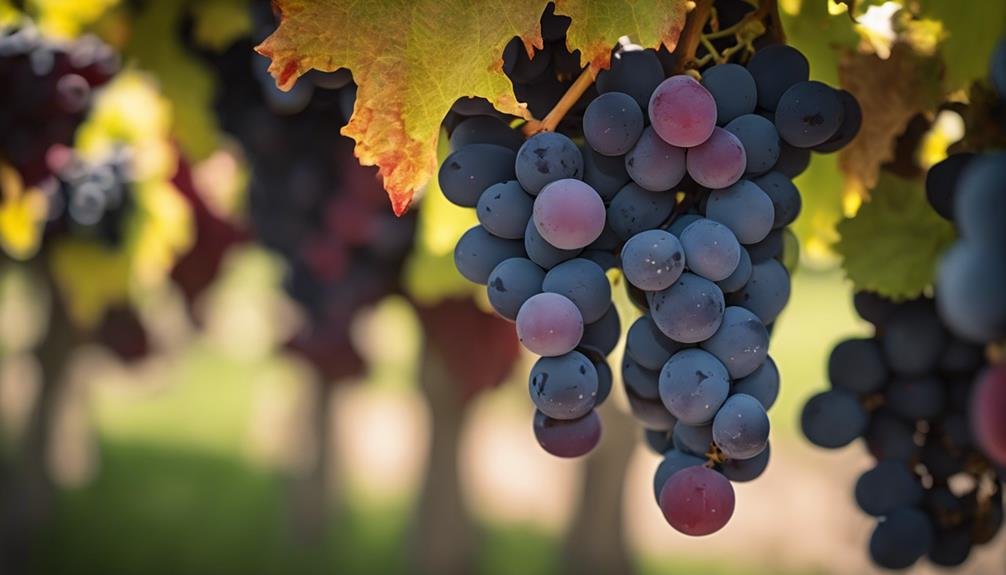Cabernet Sauvignon, Merlot, Cabernet Franc, Malbec, and Petit Verdot are key in red Bordeaux blends. White blends feature Sauvignon Blanc, Sémillon, and Muscadelle. Bordeaux's diverse terroir impacts flavor. Traditional blends focus on these grapes, while modern blends adapt to climate change. Winemakers experiment with new varieties like Arinarnoa and Marselan. Recently, forgotten grapes such as Mancin and Bouchalès are making a comeback. Understanding this evolution reveals the creativity and adaptability of Bordeaux winemakers.
Main Grape Varieties in Bordeaux Blends
When exploring Bordeaux blends, the main grape varieties that typically comprise them are Cabernet Sauvignon, Merlot, Cabernet Franc, Malbec, and Petit Verdot for red blends, while Sauvignon Blanc, Sémillon, and Muscadelle are common in white blends.
Terroir influences play a significant role in shaping the characteristics of these wines. Bordeaux, known for its diverse terroir, including gravel, clay, limestone, and sandy soils, impacts the grape development and flavor profiles.
Producers utilize blending techniques in Bordeaux to create well-balanced wines that showcase the unique attributes of each grape variety while harmonizing their flavors and textures. Understanding how these grape varieties interact with the specific terroir of Bordeaux is key to appreciating the complexity and depth of Bordeaux blends.
Traditional Vs. Modern Bordeaux Blends
The evolution of Bordeaux blends can be observed through the comparison between traditional and modern approaches in winemaking practices. Traditional winemaking techniques in Bordeaux often involve blending Cabernet Sauvignon, Merlot, Cabernet Franc, Malbec, and Petit Verdot to create complex and age-worthy wines. These blends are crafted with a focus on terroir and the art of blending different grape varieties to achieve balanced flavors.
In contrast, modern winemaking techniques aim to adapt to climate change by incorporating new grape varieties like Arinarnoa, Castets, Marselan, Touriga Nacional, and reintroducing forgotten varieties. Producers are experimenting with different grape combinations to maintain quality and consistency in their wines while adapting to changing environmental conditions.
Evolution of Bordeaux Blend Components

Exploring the dynamic landscape of Bordeaux blends, the evolution of their components reflects a continuous pursuit of innovation and adaptation in winemaking practices.
Over time, the traditional grape varieties such as Cabernet Sauvignon, Merlot, Cabernet Franc, Malbec, and Petit Verdot have been complemented by new additions like Arinarnoa, Castets, Marselan, and Touriga Nacional in red Bordeaux blends.
In white Bordeaux blends, alongside Sauvignon Blanc, Sémillon, and Muscadelle, Alvarinho and Liliorila have found their place due to changing climate conditions.
Additionally, there has been a resurgence of forgotten grape varieties like Castets, Mancin, Bouchalès, St-Macaire, and Peloursin, adding further diversity to Bordeaux blends.
This evolution showcases the adaptability and creativity of winemakers in responding to both tradition and innovation in grape selection.
Frequently Asked Questions
Can Bordeaux Blends Include Any Other Grape Varieties Besides the Traditional Ones?
Bordeaux blends can now incorporate alternative grape varieties beyond the traditional ones like Arinarnoa, Castets, and Touriga Nacional. This shift reflects a global trend towards experimenting with new world grapes to enhance flavor profiles and adapt to changing climate conditions.
Are There Specific Rules Governing the Proportions of Grape Varieties in Bordeaux Blends?
Proportional flexibility in Bordeaux blends allows for traditional grape varieties like Cabernet Sauvignon, Merlot, and Cabernet Franc to be blended in varying proportions. Modern blends may incorporate small percentages of newer or rediscovered grape varieties for added complexity and adaptation to changing climates.
How Do Changes in Climate Affect the Grape Varieties Used in Bordeaux Blends?
Changes in climate impact Bordeaux blends by altering grape varieties used. Producers adapt by incorporating new grapes like Alvarinho and Touriga Nacional. Sustainable practices and understanding terroir play pivotal roles in ensuring the quality and resilience of these blends.
Are There Any Efforts to Revive or Reintroduce Old, Rare Grape Varieties in Bordeaux Blends?
Efforts are underway in Bordeaux to revive old, rare grape varieties and introduce unique grapes into blends. Producers are rediscovering forgotten gems like Castets, Mancin, and Bouchalès, adapting to changing climates by incorporating Alvarinho and Touriga Nacional.
Which Grape Varieties Are Considered the Most Versatile for Bordeaux Blends?
The most versatile grape varieties for Bordeaux blends are Cabernet Sauvignon, Merlot, and Cabernet Franc. They form the backbone of these blends, offering complexity, structure, and balance. New world trends incorporate these classic grapes, shaping flavor profiles across regions.
Conclusion
In the world of Bordeaux blends, grape varieties come together like a well-orchestrated symphony, each playing a unique role in creating a harmonious and balanced final product.
As the vines intertwine and the flavors blend seamlessly, a masterpiece is born, enchanting the senses and leaving a lasting impression.
Bordeaux blends are a true work of art, showcasing the craftsmanship and innovation that define the world of winemaking.